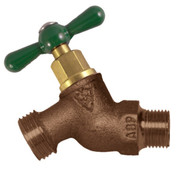Has Sillcock Design Improved With Time?
Nov 6th 2023
Some inventions and devices do not seem to change for decades or even centuries. These make us wonder if the human race is really progressing, or if we reached the point of stagnation. I remember somebody pointing out that NASA's space shuttles have not changed a bit since President Nixon commissioned them, and that was a long time ago.
And there are many other examples of pieces of old technology that continue to fulfill their role just fine, and the commercial plumbing industry does not escape this trend.
Taps and faucets have been around for at least two centuries. They became commonplace as running water became ubiquitous. Commercial plumbing, or plumbing dedicated to equipping public spaces with reliable sources of water, soon went in demand and pushed for sturdier and more stable hardware. That's when spigots or “cocks” became prevalent, especially in the industrial environment for controlling liquids and gas flow. Stopcocks were used to regulate the flow of water in residential and commercial venues, but also in industrial settings where it was necessary to completely shut down valves. On the other hand, petcocks would typically present a threaded valve to be connected to hoses.
Soon, many buildings began sporting cocks installed at the sill level. These, of course, were aptly named sillcocks. It was common to see many of these that came with a “loose key”. The reason to install loose keys or removable handles was to allow landlords to take them off to prevent vandals or passersby from using them.
Modern sillcocks have not changed much. In fact, they have become pretty much standard in every building that needs a spigot that penetrates the foundation sill or is at least at sill level. They provide access to tap water while outside of the building, and most of them have a threaded valve to be connected to a hose. In other words, sillcocks allow you to have the same comforts offered by your indoor sanitary installations.
They have become extremely important for buildings that require regular gardening, but also venues that need to regularly spray outdoor furniture like restaurants, cafés, spas, and many more.
They haven't changed much structurally. Today, the best ones are made from corrosion-resistant materials, like brass. Some of them come with shiny finishes, but it's mostly an aesthetic choice. Most commercial plumbers and venues acquire sillcocks that are durable, reliable, and capable of doing their job while remaining discreet. They also have to be able to handle exposure to elements and a fair amount of abuse since they will be often bumped with tools and other equipment.
An important change has been the amount of control offered by more modern handles. Regulating the flow of liquids is not something new, but old models were prone to clogging as they forced water through an S-shaped channel, which is no longer the case. Today handles are designed to offer a bit more resistance so the user can effectively control the flow to a greater degree.
One important change in design is the valve angle. The first spigots and cocks were pointed down at a straight 90° angle. This caused problems when connecting hoses as they would kink right at the tap. Modern sillcocks are usually pointed at a 45° degree angle, which prevents kinking, but also provides a more comfortable pouring for other tasks.
It is normal to see dual or multi-hose adapters for added convenience. Many venues require multiple outlets for increased productivity, making it imperative to provide workers with more individualized water sources.
In zones where temperatures drop drastically during winter, outdoor plumbing faced different challenges. When you close a faucet or sillcock, you effectively stop water from coming out the valve, but the pipes remain filled with liquid. When the temperature drops, this water freezes and expands, causing your pipes to burst.
One way to prevent freezing was to close the indoor valves and drain all the water from the pipes. Then close all valves during winter. This sounds easy enough to do. However, mistakes happen and users often forget to take precautions, causing damages that represent costly repairs.
A solution was to create sillcocks that go farther back into the building, where water remains a tad above freezing temperatures. These are called frost-free sillcocks. But they need to be installed properly to prevent leaks and guarantee that they do their job every winter.
As you can see, even though sillcocks still retain their old-fashioned shape, they have indeed evolved to offer more reliable access to water and many additional safety features. Today, the best sillcock brands and makers offer lead-free products following the recommendations of health experts.
If you need to find sillcocks, hose bibs, or spigots for your next project or want to make sure you can find the right plumbing repair parts, browse through our website and have access to the widest array of hardware for commercial plumbers in the country.

